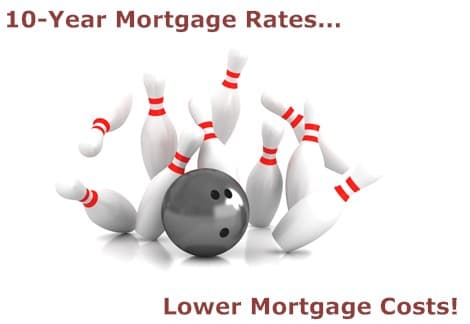10-Year Mortgage Rates - Home Loan
- 10-Year Mortgage Rates are lower than 15-year or 30-Year FRM rates.
- You will have a higher monthly payment.
- Your payments are not flexible, so make sure you have a sufficient cash flow and good savings.
10-Year Mortgage Rates: Discipline before Flexibility
10-year Mortgage Loans exist, but are uncommon. If you want to enjoy the lower 10-year mortgage rates, then make sure that you have the necessary income to meet your payments. The shorter term brings savings, but at the price of flexibility.
10-Year Mortgage Rates are generally less than 15-year mortgage rates or 30-year mortgage rates; however, you need to be a strong borrower to make the payments. Your overall savings can be great, but you will need either a small loan (large down payment) or a big net cash flow.
Deciding on which loan is appropriate for your situation and finding the best interest rate, including a 10-year fixed mortgage rate, is a daunting task. To make your process easier learn about:
- The pros and cons of a 10-year mortgage rate and loan
- Today’s mortgage rates
- How to compare your options
Pros and Cons of a 10-year Mortgage Rate and Loan
If you can afford a short-term 10-year mortgage loan, you can benefit from a lower interest rate and overall financial savings.
You need to be a strong borrower, with either strong income or assets. Here are some reasons to consider a 10-year mortgage loan:
- You have a strong positive cash flow
- You have a strong equity position in your house. This can be due to a large down payment from savings, a sold house with big profits, a sold house that you are downsizing, or low housing prices leading to a smaller loan.
On the other hand, look at your entire financial picture. While saving from lower interest rates and financial costs (after all, you are returning the money very quickly), ensure you are not harming your overall financial picture. Consider these factors:
- No flexibility: In the case of emergency costs, you cannot divert funds from your mortgage payments. Do you have a sufficient rainy day fund? (The rule of thumb is 6 months of living expenses).
- Asset Diversification: You are putting a large amount of your equity into your house. Are you diversifying your investments?
Comparing your options
10-year fixed mortgage loan rates are usually less than 15-year FRMs, however, when mortgage rates are extremely low, as in 2012, the differences are not large. Nonetheless, your monthly payment will be quite different. The table below shows monthly payments (principal and interest) for different loan periods based on a $250,000 loan:
| 10-Year FRM | 15-Year FRM | 30-Year FRM | |
|---|---|---|---|
| Interest Rate | 2.75% | 3.0% | 3.5% |
| Monthly (P&I) Payment | $2,385 | $1,711 | $1,158 |
- Monthly Payments: The 10-year FRM is $674 per month more than a 15-year loan and $1,227 more than the 30-year FRM.
- Income Requirement: Assuming that your principal and interest payment does not exceed 25% of your gross income, you will need $9,540 to qualify for a 10-year loan, versus $6844 for a 15-year FRM or $4,632 for a 30-year FRM. Remember, your lender will qualify you based on DTI ratios of between 36-43%, depending on the type of loan. Your overall DTI depends on your house-related payments (principal, interest property tax, and property insurance) and your recurring debt (credit cards, student loans, auto loans, and installment credit).
If can afford the higher payments and have the discipline and financial strength to make those payments, then consider benefiting from the 10-year mortgage rate.
